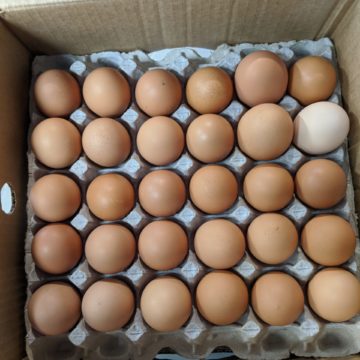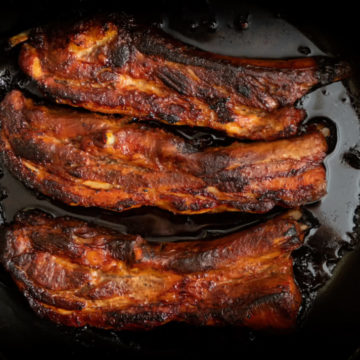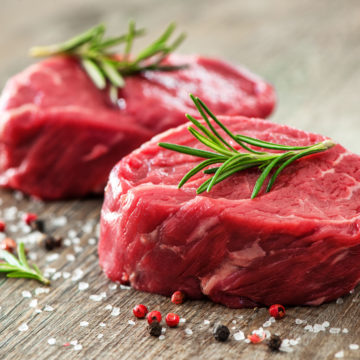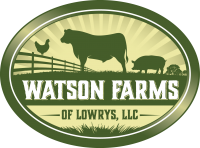From time to time, we like to highlight the differences between our methods of production and the industrial methods. With this edition we will be comparing grass-fed regenerative beef like what we raise and its industrial counterpart — grain-fed beef from feedlot cattle.
We don’t do this to denigrate other methods of farming, but rather to bring consumer understanding to a new level where they can make more informed choices. Free markets work best when consumers are fully-informed. This gives the best indication of the will of the people, because the more we know about our food system the better the choices we can make to align with our family’s goals. And when consumers vote with their food dollar, not only can our food system change very rapidly, but conventional farmers can then transition to better methods of production as well.
So lets dive in to learn about why our beef is different.
#1 – Our cattle are always on grass, never on a feedlot, and only eat grass.
There’s lots of clever ways that other brands describe their beef products from “all natural” to “pasture raised.” But many times, these descriptions don’t tell the consumer the whole truth and can be more confusing than descriptive. For example, pasture raised can mean that the animals are fed copious quantities of grain for long periods of time — it’s just done with the animal on pasture instead of a feedlot. While this method may be an improvement over the feedlot it is far from capable of imparting the health benefits that grass-fed beef consumers seek.
In order to make sure we’re all on the same page with the typical life cycle of cattle in the U.S., take a look at this infographic. Notice that even though feedlot cattle spend a good bit of their life on grass, the health benefits can vanish very quickly with only a few weeks of grain-feeding. This brings us to our next point.
#2 – Grass-fed beef has been proven time after time to contain better Omega 3 to Omega 6 ratios as well as many other health benefits. Grain-fed beef sacrifices these health benefits for cheap grain that fattens the cattle really fast. This concentrated feed ration greatly reduces finishing time which allows quicker turnover and better profits for the feedlots. Here’s another infographic to take a careful look at.
#3 – Grass-fed beef minimizes external costs while grain-fed beef maximizes external costs.
What I mean by this is that there are other costs (above the sticker price) associated with the feedlot-produced steak that you find in the supermarket. These might be things like the taxes you pay to the IRS that go toward corn subsidies in order to make feeding vast quantities of corn to beef cattle economically feasible. Another externalized cost might be the higher risk of E.coli contamination which is evident in the latest recall of more than 28,000 pounds of ground beef. Yet another might be the net carbon emission from grain-fed beef compared with the carbon sequestration that occurs with regeneratively-produced grass-fed beef. Even though we are led to believe that all cattle are responsible for carbon emission in the form of methane, it is rarely reported that properly-raised grass-fed cattle actually sequester more carbon than they emit. See the graphic below.
#4 – Our beef is Customer-verified, which we believe is far superior to any number of third-party verifications that the industry relies on to elicit trust from consumers.
We view our relationship with our customers as a partnership, and we strive to be transparent in all of our processes. We do this through videos, photos, this newsletter, but most of all, through the ability of customers to actually visit our farm. Try that with a Tyson chicken farm or a Western feedlot. Whereas we encourage pictures during tours, they prohibit them.
#5 – Lastly, we think the the depth of flavor in grass-finished beef is superior to what many describe as bland flavor in grain-fed beef. Of course, we’ve met people who completely reject the flavor of grass-fed beef, but we like to recognize first of all that not all grass-fed beef tastes the same. It really depends on the type of forage they were on, which diversifies the flavor possibilities. Second, during the finishing period we try our best to avoid grazing fescue that is not in a vegetative state. By grazing grasses that are higher in sugar, we can usually avoid the stronger gamey flavor that some customers object to. One thing to remember is that if it doesn’t taste different than conventional beef, then it may not actually be.
There are many other differences that I could go into, but we will leave it at that for fear of getting too lengthy. Thanks to all of you who are literally keeping cattle on grass instead of on the feedlot by voting with your food dollar. We used to market a large portion of our cattle through conventional channels, but now we market 100% of them directly to consumers like you. On top of that, we have had to partner with like-minded producers in order to supplement our own supply! Great things can happen when consumers and farmers decide to make a change.
Submit Your Food Photos!
We have added a page on our website that brings together all of the posts and photos from Facebook and Instagram that mention us (Facebook: @Watson Farms Pastured Meats, Instagram: @watsonfarmsbeef).
Or if social media isn’t your thing, then you can use a form on the webpage to upload your photo straight to us.
Whichever way you choose, we love seeing how our customers are using our products!
We have revamped our Referral Program!
It’s now easier than ever to Give $15 and Get $15 through our Referral Program. We don’t spend a lot of money of advertising, but rather we focus on producing products that people love and are willing to tell others about. So we depend on word of mouth to find new customers and ultimately to heal more land.
So in an effort to streamline this process we have made it easier to tell others (via email, Facebook, or Twitter) about Watson Farms. And it’s all automated on the backend, so you don’t have to rely on us to issue the store credits manually. Just head over to our Referrals Page and start sharing!
Product Spotlight
We have placed a couple beef items on sale in addition to our XL eggs. These are beef ribs and filet and we’re offering them at a deep discount for a limited time! Ribs are over 40% off and filet is over 30% off!
-
 Bulk Eggs (flats)$37.50 – $83.85
Bulk Eggs (flats)$37.50 – $83.85 -
 Beef Ribs$22.48
Beef Ribs$22.48 -
 Filet Mignon$41.30
Filet Mignon$41.30
You can see ALL of our ON SALE products with the button below.
For some of our recommended products, check out our Featured Product Page. You might find something that you didn’t even know we had!
We re-use packaging!
We’ve seen a good response to our efforts in re-using packaging! Thanks and keep it up.
You can help us reduce our carbon footprint by returning your CLEAN egg cartons and meat boxes.
The main reason that we switched to plastic egg cartons a while back was because they are so much more durable than paper which could only be used once. They also protect the eggs much better!
So if you have some egg cartons or boxes to return, you can just place them on your porch on your home delivery day. Farm pickup customers can, of course, drop them off when you come to pick up your new order.
***We can only re-use OUR cartons or boxes. Please re-use or recycle other boxes or egg cartons elsewhere.***
Thanks for helping us re-use our packaging!
Order Deadlines and Store Hours
Charleston and Columbia Areas: 12 noon Mondays
UPS Orders: 12 noon Mondays
GSP: 12 noon on Wednesdays
Charlotte/Fort Mill/Rock Hill Areas: 12 noon Fridays
Farm Pickup: Please wait until you receive an email stating that your order is ready to be picked up (usually 1 business day from when you place your order). Farm pickup is done during store hours:
Monday, Tuesday, Thursday, Friday: 10am to 6pm
Saturday: 10am to 2pm
Closed Sunday and Wednesday
Did you know that we have a webpage that displays all the reviews we have received?
Check it out!
Check out this ⭐⭐⭐⭐⭐ review:
“I’ve been ordering from Watson’s Farm for about 3 years now. LOVE their subscription box. It’s an affordable option for our family to get most of our meat from a reputable source. I especially love the ease of farm pick up, and getting to interact face to face with our farmers. The quality of meat is everything one could hope for. It comes prepackaged, frozen, and the box is clearly labeled with each item and weight. I get the 15lb box, and on average I would say I get at least 5-6 different cuts of meat, usually from at least two animals– sometimes even all three (beef, chicken and pork) depending on the time of year. My cooking has become more flexible, and we get to try new dishes we may not have thought of before. I have never, ever had a problem with their product or service!“
We would greatly appreciate it if you would be kind enough to leave us a review. It helps first-time customers purchase with confidence.
Thanks again for being partners in this endeavor of local, pasture-raised proteins that has truly transformed our farm. We look forward to continuing this transition while serving you long into the future.
Sincerely,
The Watsons
Pasture Posts is written by Matt Watson.



